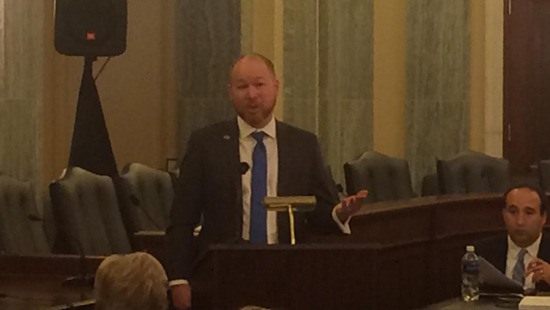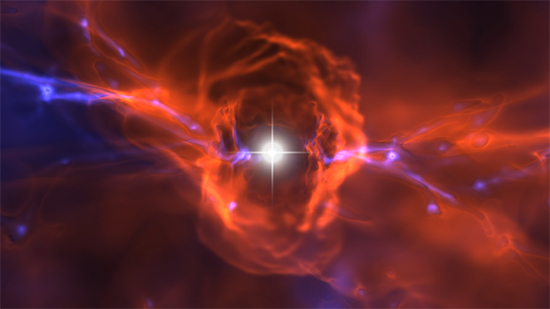
Download this episode
Possible scenarios for the birth of stars, galaxies, and black holes come alive in the data crunching and visualizations of John Wise, a professor in the School of Physics. Wise explains how his simulations and visualizations – some of which have won awards – help researchers “rewind” space and time back to the origins of the universe.[Upbeat music]
- Renay San Miguel:
-
Hello, I’m Renay San Miguel, and this is ScienceMatters, the podcast of the Georgia Tech College of Sciences.
- Solar Superstorms video:
-
A fury is building on the surface of the sun…jets of super-hot gas…rising waves of fire…the most violent explosions in our solar system.
- Renay San Miguel:
-
Yes, that’s the voice of Marvel’s Doctor Strange, Benedict Cumberbatch, narrating a documentary on solar storms raging on the sun’s surface.
- Solar Superstorms video:
-
Journey into our star…to explore its inner workings…
- Renay San Miguel:
-
The choice of narrator in this National Science Foundation, or NSF, video is appropriate: The documentary’s visualizations, built from gazillion bits of data on supercomputers, look like they’re from a Hollywood sci-fi blockbuster. Clouds of swirling yellow gases mix with the deep reds and oranges of the simulated sun’s surface.
- Solar Superstorms video:
-
…and experience the power…of solar superstorms.
- Renay San Miguel:
-
On May 25, 2016, Cumberbatch’s voice echoed through a Capitol Hill briefing room as the Solar Superstorms documentary screened for Congressional staffers. Scientists who worked on the video spoke about the need for more research on space weather like solar storms, and how important supercomputers are in that effort. Another voice joined Cumberbatch’s at the briefing in Washington D.C. — that of John Wise, the Dunn Family Associate Professor of Physics at Georgia Tech.
 John Wise:
John Wise:-
So that’s where I had to testify about where supercomputers come into the scientific process, and how they’re very useful tools.
- Renay San Miguel:
-
They certainly have been for Wise. He uses supercomputers, and hundreds of terabytes of data, to put together computational simulations of cosmological events. Keep in mind that 1 terabyte equals a trillion bits of data – that’s 1 followed by 12 zeroes. Wise’s simulations open a window to the birth galaxies, stars, black holes. Through further computer visualization wizardry, he then converts those simulations into spectacular videos. The spectacle, however, shouldn’t overshadow the value these visualization tools bring to scientists. Wise is building potential models for how galaxies are born. He’ll then check data from physicists and see if they fit one of his models. If they match up, he’s built a possible representation of what happened millions of years ago, when cosmic dust was still coming together to form stars and galaxies. First Light in the Renaissance video: Time-evolving visualizations give insight into dynamics that are impossible to understand from quantitative analysis alone. Only through simulations can we study this era.
- Renay San Miguel:
-
That’s from a 2017 visualization Wise worked on called “First Light in the Renaissance,” about the formation of the very first galaxies. The computers needed to make the data come alive for all of us to see must have powerful computer cores, or processors, to crunch all that digital information. Georgia Tech has a supercomputer, but it doesn’t have enough power to perform these supermassive computations. Wise uses National Science Foundation-funded supercomputers for his visualizations, which have won awards. His work is in the Solar Superstorms documentary. We begin our conversation with Wise with his definition of computational cosmology, and how computers now play a vital role in the search for the origins of the universe.
- John Wise:
-
So cosmology is the study of the universe as a whole, but it evolves over millions, even billions, of years, and to actually understand how it evolves over these long time scales, we can use computers to actually see how they evolve — along with the galaxies — how they evolve and form stars. And computers we use as a tool. We can use the vast range of processors around the nation, these supercomputers around the nation, and you know, we program these tremendous codes to actually crunch the numbers that physics tells us. These computer codes, they have the physics equations in them, and we have the, actually have a set of initial conditions, and the physics tells that box what to do, and it evolves over time and we study how the system of the universe evolves.
- Renay San Miguel:
-
What is the attraction for you with this? This isn’t exactly like looking through a telescope, or checking out radio telescope readings, that kind of thing. Why have you built up all this experience running these data simulations on a variety of supercomputers around the world? What’s in it for you?
 John Wise:
John Wise:-
Well, I like programming to start out with, and I also like physics and astronomy. I’ve always liked math and science as a kid, and then I discovered programming when I was 14 at a summer school. And to do this, you have to enjoy what you do. Yeah, so, physics is really intriguing and it tells us how nature works, and we can use computers, these supercomputers. We have to program them to do what nature wants us to do, and I enjoy programming, so I enjoy that and by doing that we get to understand how the universe works.
- Renay San Miguel:
-
Why would you need to use numerical simulations in the first place to study how galaxies and black holes are formed? How would that information be more useful to you then, say, the latest observatory telescope photos or the latest data from radio telescopes?
- John Wise:
-
When you look through a telescope, it’s just a snapshot in time. You can’t just lay back and watch it evolve like typical experiments on Earth, where we have to look at the data from the telescope or radio telescope that we have, and we have to match it with these simulations, and if we get a match like something similar, a similar galaxy in the simulation, we can actually go back in time in the simulation and actually see how it evolves and forms.
- Renay San Miguel:
-
You can kind of rewind.
 John Wise:
John Wise:-
That’s right. Yeah, yeah, it’s really cool to see all this in action, and we can compress 10 billion years in one minute of visualization. [Upbeat music]
- Renay San Miguel:
-
Now that says to me that you’re working with some extremely powerful supercomputers. What exactly is needed to crunch this kind of data for your visualizations?
- John Wise:
-
First we need to produce the simulation. It’s a lot of data that’s being produced on the order of a terabyte, 10 terabytes, even up to 100 terabytes of data, and we work with all sorts of computers. How we actually developed this, we developed this on regular laptops and desktops. We can run small simulations to actually get the code working to our satisfaction, and then you work up to larger and larger computers. Like at Tech, we have a supercomputer that has about 20,000 computer cores, and so we do medium-scale simulations on those, taking about the power of a thousand laptops, a thousand cores, and then we can move to national supercomputers which nowadays have a million cores, yeah.
- Renay San Miguel:
-
How much more powerful are those computers than what we have here at Georgia Tech?
- John Wise:
-
It’s about 10 times larger, yeah, and If you’ve ever gone, if you’ve ever seen one of these, they take up a whole room, and they’re so noisy with all the fans.
- Renay San Miguel:
-
Where do you do most of your visualization work when it comes to those larger computers? Where are the national supercomputers that you use?
 John Wise:
John Wise:-
So the main one that I use is an NSF computer called Blue Waters. It’s at the University of Illinois at the NCSA, the National Center for Supercomputer Applications. So we do most of our simulations there and it’s hard to move data back and forth, so I try to do as much visualization as I can onsite there. But if I really want to dig into it, I can transfer some data over here to our supercomputer, or even sometimes it fits on my desktop because I have — like one snapshot of our visualizations is usually around 100 gigabytes, which fits on a hard drive.
- John Wise:
-
That’s why we have so many hard drives, I have 10 terabytes of space on my desktop here, yeah, so it’s huge and it requires a lot of work, we have to kind of isolate what we want to look at and then we can visualize that and get a better idea of what’s going on.
- Renay San Miguel:
-
And some idea of the time involved in getting to that point?
- John Wise:
-
The simulation itself can take anywhere from three weeks or months to run. So the longest simulation we’ve ever run took nine months to run on this Blue Waters machine, and to actually visualize it, it’s a work in progress where you do some low-resolution image and then you work up to production quality, and that probably takes a week or two weeks to actually get just right. [Upbeat music]
- Renay San Miguel:
-
You’ve been able to break new ground in astrophysics using these simulations?
- John Wise:
-
Yes, definitely. Because you know, we run this huge simulation as a bunch of zeros and ones. It’s a lot of data, but to actually understand what’s going on we have to visualize it first to understand how they evolve over time. And what’s interesting in these galaxies, and a lot of work has been put into the visualization software, first you run the simulations that’s all the physics and visualization that has some physics, but a lot of it is art, as in what kind of color do you pick, how opaque things are, how transparent things are, to make it visually appealing and how to make things kind of pop at you, which is kind of what they do in Hollywood.
- Renay San Miguel:
-
Did these simulations help you with a study you released in March of 2017 that theorized how fast a supermassive black hole could grow, and it all depends on how big the neighboring galaxies are and what kind of gravitational pull is there? Did what you’re doing with simulations here help you with that study?
- John Wise:
-
They did. We saw an instance where a supermassive black hole could have formed, and we’re wondering why, so by visualization we could see, like, nearby galaxies and what was actually causing that collapse. It’s actually a massive gas cloud that collapses but doesn’t form stars. In normal circumstances they would collapse and form stars.
By looking at what was actually happening by visualizations, this helped us understand what was going on, and by doing so we had a picture in our mind then, and then we could actually dig into the data even more and get into physical quantities, like how massive was the object? How quickly was the gas blowing into toward this proto-black hole?”
- Renay San Miguel:
-
Wise says visualizations also help the human eye recognize patterns in what they’re seeing, which can lead scientists in new directions within the data. He hopes the addition of machine learning soon can help his computers spot those patterns within the simulations. In the meantime, his visualizations could plant the seeds of discovery, and a lifelong passion for studying the cosmos, in students.
- John Wise:
-
Some of my visualizations have been shown in planetariums, so high school students, K-12 students have gone through this planetarium, and yeah, for a kid to actually see those and be wowed by universe can make an imprint on them at a young age and kind of launch them into scientific careers.
I actually participate in something called STEM Power at Georgia Tech, and this is where Girl Scouts — last month we had about 100 Girl Scouts come through, and we have a visualization studio here which has 3D capabilities, so they want several 3D movies of our simulations, so they’re great. They’re brilliant, they’re like, I think the girls were between eight and 12 years old, and their questions were outstanding.
- Renay San Miguel:
-
Have you ever seen the result of one of your visualizations, all this work you put in, and you yourself was just blown away? You’re sitting there, your jaws’ on the floor, and you’re going, ‘Wow, I had no idea this could look that good?’
- John Wise:
-
Yeah. I mean, especially going to scale. I can make a small image, something pretty small like 200 pixels across just to test things out, but when I make the real deal at ultrahigh resolution, say like at 4K resolution or even at 8K resolution, this is when I’m wowed. When things, you know, are shown on the big screen, and in 3D as well, I just, sometimes making pretty pictures, that’s one of my favorite parts of this job — to see everything, all our work in the past months or years put together in this beautiful visualization.” 19:52 [Upbeat music]
- Renay San Miguel:
-
That’s John Wise, the Dunn Family Associate Professor in the School of Physics. The focus of Wise's research group for the rest of 2018 will be to continue studying how the first stars and galaxies form, and how they might appear through next-generation telescopes, such as NASA's James Webb Space Telescope, set to launch in 2020.
Our thanks to Siyan Zhou, first-year Ph.D. student and a former research associate with the School of Psychology, for composing our theme music. I’m RSM, and you’ve been listening to ScienceMatters, the podcast of the Georgia Tech College of Sciences. [Upbeat music]


